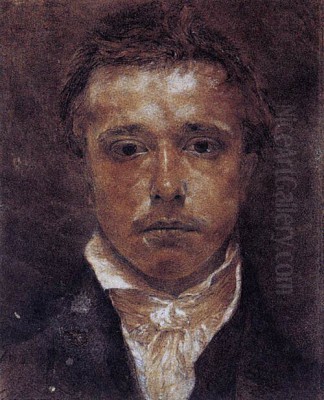
Samuel Palmer stands as one of the most distinctive and visionary figures in the history of British art. Active during the height of the Romantic era, Palmer (1805-1881) was a landscape painter, etcher, and printmaker whose work transcended mere topography to explore realms of spiritual intensity and pastoral idealism. Though largely underappreciated during his lifetime, his unique artistic language, particularly the works created during his youthful immersion in the Kent countryside, has secured his legacy as a crucial influence on later generations of artists and a master of evocative, dreamlike imagery. His journey was one of early promise, profound spiritual encounters, intense creative flowering, and later struggles, culminating in a posthumous recognition that continues to grow.
Early Life and Artistic Awakening
Samuel Palmer was born on January 27, 1805, in Newington, then part of Surrey but now absorbed into South London. His upbringing was steeped in literature and piety. His father was a bookseller and a lay Baptist preacher, fostering an environment where reading and religious thought were central. His grandfather was a poet, further enriching the young Palmer's imaginative world. From an early age, Palmer displayed a sensitivity to both the natural world and the power of the written word. He devoured works like John Milton's poetry, whose rich descriptions and spiritual undertones deeply resonated with him.
This early immersion in literature and nature shaped his artistic inclinations. He developed a particular fascination with the transformative effects of moonlight on the landscape, seeing in it a mystery and beauty that transcended the everyday. His artistic talent emerged early; remarkably, he first exhibited landscape paintings at the Royal Academy at the tender age of fourteen. These early works, though perhaps technically immature, already hinted at a unique sensibility and a desire to capture more than just the surface appearance of nature.
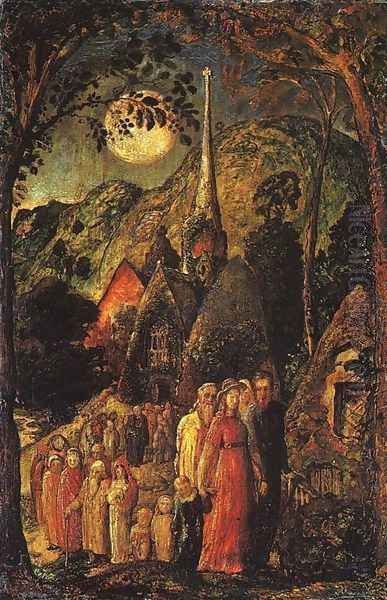
His formal training was limited, but his passion for art was intense. He sought out mentors and influences who could guide his development. The London art world of the 1820s was a place of diverse currents, moving away from the strictures of Neoclassicism towards the more personal and emotional expressions of Romanticism, a movement finding powerful exponents in figures like J.M.W. Turner and John Constable, though Palmer would forge his own, very different path.
The Guiding Hand of Linnell and the Revelation of Blake
A significant turning point came in 1822 when Palmer met John Linnell. Linnell was an established and successful painter, engraver, and portraitist, older than Palmer and well-connected within the art establishment. He became a crucial mentor, offering practical advice, technical guidance, and encouragement. Linnell's own work often displayed a detailed naturalism, and he encouraged Palmer to ground his art in careful observation of the natural world, a discipline that would underpin even Palmer's most imaginative creations.
However, Linnell's most transformative contribution to Palmer's life and art was his introduction, in 1824, to the aged poet, painter, and visionary William Blake. This encounter was nothing short of a revelation for the nineteen-year-old Palmer. Blake, then in his late sixties, was an isolated figure, largely dismissed by the mainstream art world but revered by a small circle of younger artists for his spiritual intensity and radical artistic independence.
Palmer was immediately captivated by Blake's personality and his art. He saw in Blake an artist who dared to depict the spiritual world, who rejected materialism, and whose work pulsed with an inner conviction. Blake's engravings and illuminated books, with their powerful lines, unconventional compositions, and fusion of text and image, offered Palmer a model for an art that was both deeply personal and spiritually resonant. Blake, in turn, recognized a kindred spirit in Palmer, admiring the younger artist's sketches and encouraging his visionary tendencies. This mentorship, though relatively brief due to Blake's death in 1827, set the course for Palmer's most intensely creative period.
The Ancients and the Shoreham Idyl
Inspired by Blake's example and seeking an escape from the perceived corruptions and materialism of London, Palmer became the central figure in a group of young artists who called themselves "The Ancients." This informal brotherhood, formed around 1824, included figures like George Richmond, Edward Calvert, Frederick Tatham, the engraver Welby Sherman, Francis Oliver Finch, and Henry Walter. They shared a reverence for Blake, a disdain for modern industrial society, and an admiration for 'primitive' art – the perceived purity and spiritual depth they found in medieval manuscripts, early Renaissance masters like Albrecht Dürer, and Blake himself.
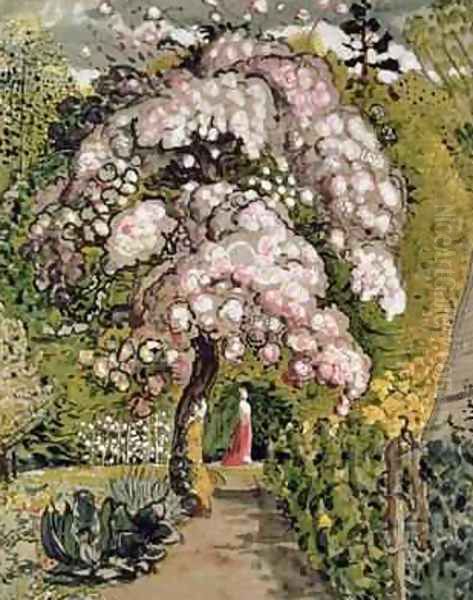
Their spiritual home became the village of Shoreham in the Darent Valley, Kent, where Palmer moved around 1826. He rented a dilapidated cottage, affectionately nicknamed "Rat Abbey," and immersed himself in the surrounding landscape. The other Ancients were frequent visitors, spending time drawing, discussing art and religion, and attempting to live a life closer to their artistic and spiritual ideals. Shoreham, for Palmer, became a terrestrial paradise, a "Valley of Vision," where the ordinary landscape seemed charged with divine immanence.
This period, lasting until about 1835, represents the zenith of Palmer's visionary art. It was a time of extraordinary creative intensity, resulting in a body of work unlike anything else in British art. He worked primarily in watercolour, ink, and gouache, often on a small scale, but imbued his scenes with monumental feeling.
The Visionary Landscapes of Shoreham
The works Palmer produced during his Shoreham years are characterized by their intensity, richness, and deeply personal symbolism. He abandoned conventional perspective and naturalistic colour in favour of an expressive, almost ecstatic style. Colours are deep and jewel-like – intense blues, glowing yellows, earthy browns, and phosphorescent whites. Paint is often applied thickly, using techniques like gum arabic to enrich the watercolour and create textured, impasto-like surfaces that seem to shimmer with inner light.
His subjects were the fields, hills, woods, and villages around Shoreham, but transformed through his visionary lens. He depicted overflowing harvest moons casting an ethereal glow over ripe cornfields, ancient churches nestled among rolling hills, shepherds watching their flocks under star-studded skies, and winding paths leading through dense, mysterious woods. Works like Coming from Evening Church (c. 1830), In a Shoreham Garden (c. 1829), Cornfield by Moonlight with the Evening Star (c. 1830), and The Magic Apple Tree (c. 1830) exemplify this period.
These landscapes are suffused with a sense of abundance, fertility, and spiritual presence. Sheep appear plump and contented, corn stands impossibly thick, trees are heavy with fruit, and the moon and stars blaze with supernatural intensity. Human figures, often shepherds or farm workers, seem integrated into the rhythms of nature and imbued with a quiet piety. Palmer drew inspiration from the Bible, Virgil's Eclogues, and Milton, weaving literary and religious allusions into the fabric of his landscapes. It was an art of intense feeling, fusing meticulous observation of natural detail with a profound spiritual and emotional response. He sought, as he put it, to capture the "primitive, pastoral, and poetic" essence of the landscape.
Return to London, Marriage, and Italy
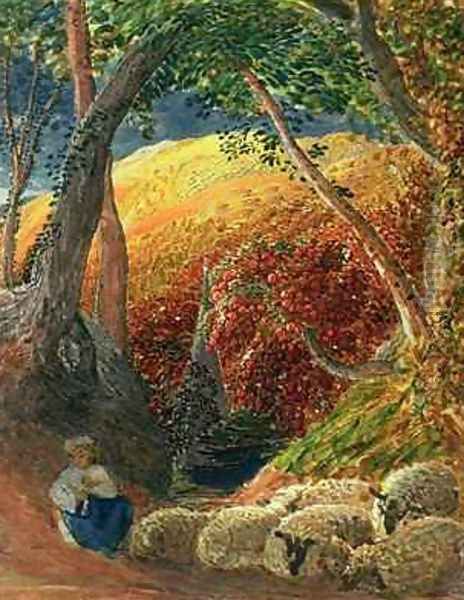
Around 1835, the Shoreham idyll began to fade. The Ancients group gradually dispersed, and Palmer felt the need to re-engage with the London art world and establish a more conventional career. He returned to the city, taking a house in Marylebone, funded partly by a small inheritance. His style began to shift, moving away from the intense, enclosed visions of Shoreham towards a broader, more naturalistic approach to landscape.
In 1837, Palmer married Hannah Linnell, John Linnell's eldest daughter. The marriage connected him further to the art establishment but also brought new pressures. John Linnell, ever practical, encouraged his son-in-law to adopt a more commercially viable style, one that might appeal to contemporary tastes favouring topographical accuracy and picturesque effects, closer perhaps to the popular watercolours of the day or the atmospheric breadth seen in Turner's work, albeit without Turner's dramatic dynamism.
Shortly after their marriage, Samuel and Hannah embarked on a two-year trip to Italy (1837-1839). Italy was a traditional destination for British artists, offering classical ruins, stunning scenery, and the legacy of Renaissance and Baroque art. Palmer sketched diligently, absorbing the light and landscape, and studying the works of Old Masters, particularly Claude Lorrain, whose idealized classical landscapes influenced Palmer's later compositions. The Italian works show a greater emphasis on light, atmosphere, and panoramic views, marking a distinct change from the intensity of the Shoreham period.
Later Career and the Turn to Etching
Upon returning to England, Palmer settled into the life of a professional artist, exhibiting regularly at the Royal Academy and the Old Water-Colour Society. He produced many competent and often beautiful watercolours of English and Welsh scenery, as well as Italian subjects based on his earlier sketches. These later works are often characterized by warmer colours, more conventional compositions, and a greater emphasis on picturesque detail. While technically accomplished, they generally lack the visionary fire and startling originality of the Shoreham paintings. Some critics felt he had compromised his unique genius for a more acceptable, but less profound, style.
Despite producing a large body of watercolour work, Palmer struggled financially for much of his life. He supplemented his income by teaching drawing. His unique early style found few buyers, and even his more conventional later works did not always achieve the success he hoped for. He faced personal tragedies as well, including the death of his eldest son, Thomas More Palmer, in 1861, a loss that deeply affected him.
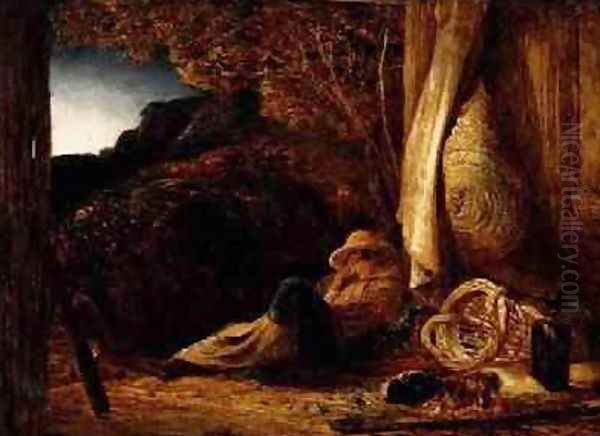
In the later decades of his life, Palmer found a new and powerful medium for his artistic expression: etching. He had experimented with the technique earlier, but from the 1850s onwards, he devoted increasing energy to it, becoming one of the great masters of the medium in the 19th century. Etching allowed him to work in black and white, exploring contrasts of light and shadow with extraordinary subtlety and richness. His meticulous technique, often involving dense networks of lines, created plates of remarkable tonal depth and atmospheric power.
His etchings often revisited the pastoral and poetic themes of his Shoreham years, but with a mature, sometimes melancholic, wisdom. Works like The Sleeping Shepherd (1857), The Early Ploughman (c. 1861), The Bellman (1879), and The Lonely Tower (1879) are masterpieces of the etcher's art. The Lonely Tower, inspired by Milton's 'Il Penseroso', is particularly famous for its evocative depiction of a solitary tower under a crescent moon, capturing a mood of profound poetic mystery. His most ambitious late project was a series of etchings illustrating Virgil's Eclogues, commissioned by the solicitor Leonard Rowe Valpy. Though incomplete at his death, the finished plates demonstrate his enduring connection to the pastoral ideal and his mastery of the etched line.
Death and Posthumous Rediscovery
Samuel Palmer died on May 24, 1881, in Redhill, Surrey, at the age of 76. At the time of his death, his reputation rested primarily on his later watercolours and his etchings. The intense, visionary works of the Shoreham period were largely unknown or dismissed as youthful eccentricities. His surviving son, A. H. Palmer, while writing a biography of his father and organizing an exhibition in 1881, tragically destroyed a large quantity of Palmer's early sketchbooks and paintings, deeming them unworthy or too revealing.
However, the early 20th century witnessed a remarkable rediscovery and reappraisal of Palmer's Shoreham work. Critics and collectors like Martin Hardie began to recognize the unique power and originality of these early paintings. Exhibitions in the 1920s brought this body of work to wider attention, and its influence began to permeate the British art scene. The poet W.B. Yeats was an early admirer, recognizing the mystical quality of Palmer's vision.
Palmer's art, particularly the Shoreham period, resonated strongly with a new generation of British artists reacting against academicism and seeking a more personal, emotionally charged connection to the landscape. His work became a key inspiration for the Neo-Romantic movement that flourished in Britain from the 1930s through the 1950s.
Legacy and Influence
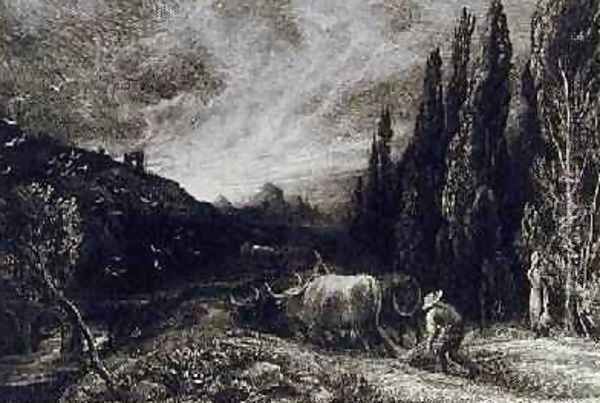
Samuel Palmer's influence on subsequent British art has been profound and enduring, particularly that of his Shoreham period. His unique blend of intense observation, spiritual fervour, and poetic imagination offered a powerful alternative to both academic naturalism and the more objective landscape traditions represented by artists like John Constable.
His most direct artistic heirs were the Neo-Romantics. Artists such as Paul Nash, Graham Sutherland, John Piper, John Minton, and Michael Ayrton drew heavily on Palmer's example. They admired his ability to imbue the English landscape with mystery, emotion, and a sense of ancientness. Sutherland, for instance, explicitly acknowledged Palmer's influence on his Pembrokeshire landscapes, finding parallels between Palmer's Kentish valleys and the Welsh hills. Nash's paintings of Wittenham Clumps and other charged landscapes echo Palmer's visionary intensity. John Piper's dramatic depictions of churches and ruins also owe a debt to Palmer's romantic sensibility.
Beyond the Neo-Romantics, Palmer's influence can be seen in the revival of printmaking in Britain. Etchers like F. L. Griggs were deeply inspired by Palmer's technical mastery and poetic vision. His work also appealed to illustrators who valued imaginative intensity.
Palmer's legacy lies in his demonstration that landscape painting could be a vehicle for profound spiritual and emotional exploration. He showed how the specific details of a place – a field, a tree, a moonlit lane – could be transformed into symbols of a deeper reality. While contemporaries like Turner explored the sublime through dramatic light and atmosphere, and Constable sought truth in empirical observation, Palmer forged a unique path, creating an intensely personal, mystical, and enduringly resonant vision of the English pastoral. His work continues to captivate viewers with its strange beauty and its glimpse into a world saturated with spiritual meaning. He remains a singular figure, a visionary who found paradise in a Kentish valley and translated it into an art of unforgettable intensity.